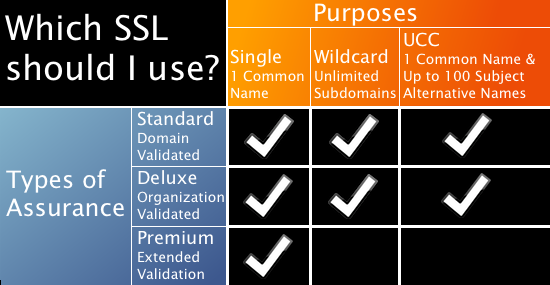Getting Started with SSL Certificates
An SSL certificate on your website builds a secure, encrypted connection between the browser and your Web server that lets visitors submit sensitive information, such as payment details, securely.
We offer multiple certificate types, so before you purchase an SSL certificate be sure to review your server configuration, and consider how you plan to use the SSL certificate.
After you purchase an SSL, request the certificate in your account. Depending on the certificate type, we verify requests with the domain registrant and possibly other factors before we issue the signed certificate.
When your certificate is issued, download all of the files from your account and install them on your Web server to secure your site. If your website is hosted in the same account, we automatically install the SSL and update the IP address for your website when your SSL is approved.
Selecting the Right SSL for Your Website
Some websites or servers have specific SSL certificate requirements. Review your business needs and server configuration, then check out Which SSL do I need?
Here's a quick overview of the certificate types:
Standard Single Domain SSL — If you need to encrypt information for only one Web address, coolexample.com for example, use the single SSL. The single SSL works well for shopping cart sites, and is also a good way to encrypt logins on your site.
One certificate protects www.coolexample.com and coolexample.com.
Single Domains with Unlimited Sub Domains (Wildcard) SSL — With a wildcard, you can request the certificate for *.coolexample.com to secure subdomains such as photos.coolexample.com, blog.coolexample.com, email.coolexample.com, and more.
Multiple Domain UCC SSL — A multiple domain UCC certificate is ideal for Microsoft Office® Communications Server, Exchange 2007 and 2010 Server, or other enterprise applications, and single companies or entities with many related URLs. However, this certificate is not recommended for sites where content or businesses are unrelated.
If you're still stuck on which certificate to purchase, use this graph to cross-reference the assurance you need with the number of domains or subdomains you need to secure:

For more information about certificate types, see the following articles:
What is the difference between a Premium Extended Validation (EV) Certificate and a Deluxe SSL Certificate?
What is a Multiple Domain (UCC) SSL Certificate?
What is a Wildcard SSL certificate?
Requesting the SSL in Your Account
After you purchase an SSL credit, how you submit the request for a certificate in your account varies depending on the type of certificate and where you're installing the SSL.
Request an SSL certificate
Request an SSL certificate
Request an SSL certificate
Adding an SSL Certificate
Adding an SSL Certificate and Site Seal to Quick Shopping Cart
Installing the SSL on Your Website
When the certificate is issued, we send an email to let you know. What happens next depends on where you're hosted and the options you selected when you requested the certificate.
If you selected Web Hosting, Grid Hosting, Website Builder, Quick Shopping Cart® or Dream Web Site when you requested your certificate, we automatically update the IP address for your website when your SSL is approved.
If you host your website with another provider, or you use one of our VPS or Dedicated Server solutions, see the article Installing an SSL: Server Instructions for information about installing the SSL on your server.
NOTE: For third-party hosting or a Virtual Private or dedicated hosting plan, you must reinstall a UCC certificate every time you need to add or remove a subject alternative name (SAN). Therefore, when possible, we recommend assigning all your SANs before you install the certificate. For information on adding or dropping SANs, see Adding or Dropping Subject Alternative Names from UCC Certificates.
Additional SSL Resources
If you want to learn more about SSL certificates, or you have additional questions, check out these resources to learn more:
Which browsers and devices are your SSL certificates compatible with?
Understanding SSL Certificate Issuance Time Frames
Understanding SSL Certificates
Which countries are currently supported for certificate issuance?
Phasing Out Intranet Names and IP Addresses in SSLs
Where can I get information about my SSL's configruation?